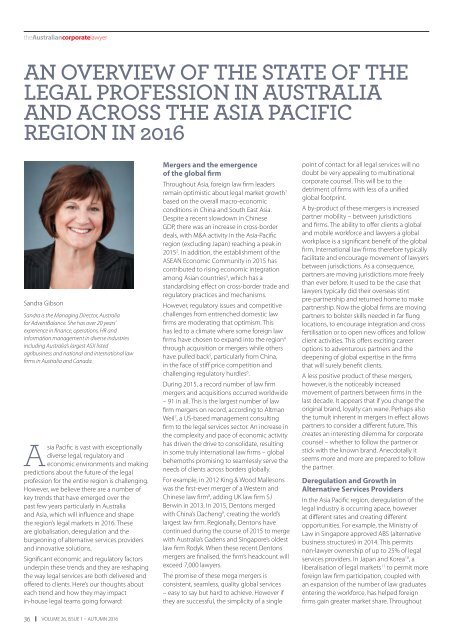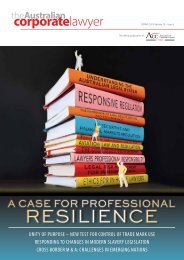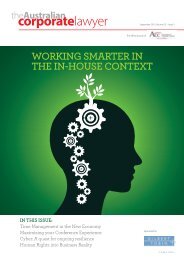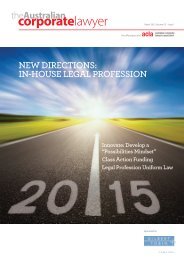Australian Corporate Lawyer - Autumn 2016
Australian Corporate Lawyer is the official publication of the Association of Corporate Counsel (ACC) Australia. The Autumn 2016 issue focuses on 'Advancing your in-House Career' and features a range of articles covering topics including: managing stress; trade marks and domain names; career motivated misconduct and cultural diversity.
Australian Corporate Lawyer is the official publication of the Association of Corporate Counsel (ACC) Australia. The Autumn 2016 issue focuses on 'Advancing your in-House Career' and features a range of articles covering topics including: managing stress; trade marks and domain names; career motivated misconduct and cultural diversity.
You also want an ePaper? Increase the reach of your titles
YUMPU automatically turns print PDFs into web optimized ePapers that Google loves.
the<strong>Australian</strong>corporatelawyer<br />
AN OVERVIEW OF THE STATE OF THE<br />
LEGAL PROFESSION IN AUSTRALIA<br />
AND ACROSS THE ASIA PACIFIC<br />
REGION IN <strong>2016</strong><br />
Sandra Gibson<br />
Sandra is the Managing Director, Australia<br />
for AdventBalance. She has over 20 years’<br />
experience in finance, operations, HR and<br />
information management in diverse industries<br />
including Australia’s largest ASX listed<br />
agribusiness and national and international law<br />
firms in Australia and Canada.<br />
Asia Pacific is vast with exceptionally<br />
diverse legal, regulatory and<br />
economic environments and making<br />
predictions about the future of the legal<br />
profession for the entire region is challenging.<br />
However, we believe there are a number of<br />
key trends that have emerged over the<br />
past few years particularly in Australia<br />
and Asia, which will influence and shape<br />
the region’s legal markets in <strong>2016</strong>. These<br />
are globalisation, deregulation and the<br />
burgeoning of alternative services providers<br />
and innovative solutions.<br />
Significant economic and regulatory factors<br />
underpin these trends and they are reshaping<br />
the way legal services are both delivered and<br />
offered to clients. Here’s our thoughts about<br />
each trend and how they may impact<br />
in-house legal teams going forward:<br />
Mergers and the emergence<br />
of the global firm<br />
Throughout Asia, foreign law firm leaders<br />
remain optimistic about legal market growth 1<br />
based on the overall macro-economic<br />
conditions in China and South East Asia.<br />
Despite a recent slowdown in Chinese<br />
GDP, there was an increase in cross-border<br />
deals, with M&A activity in the Asia-Pacific<br />
region (excluding Japan) reaching a peak in<br />
2015 2 . In addition, the establishment of the<br />
ASEAN Economic Community in 2015 has<br />
contributed to rising economic integration<br />
among Asian countries 3 , which has a<br />
standardising effect on cross-border trade and<br />
regulatory practices and mechanisms.<br />
However, regulatory issues and competitive<br />
challenges from entrenched domestic law<br />
firms are moderating that optimism. This<br />
has led to a climate where some foreign law<br />
firms have chosen to expand into the region 4<br />
through acquisition or mergers while others<br />
have pulled back 5 , particularly from China,<br />
in the face of stiff price competition and<br />
challenging regulatory hurdles 6 .<br />
During 2015, a record number of law firm<br />
mergers and acquisitions occurred worldwide<br />
– 91 in all. This is the largest number of law<br />
firm mergers on record, according to Altman<br />
Weil 7 , a US-based management consulting<br />
firm to the legal services sector. An increase in<br />
the complexity and pace of economic activity<br />
has driven the drive to consolidate, resulting<br />
in some truly international law firms – global<br />
behemoths promising to seamlessly serve the<br />
needs of clients across borders globally.<br />
For example, in 2012 King & Wood Mallesons<br />
was the first-ever merger of a Western and<br />
Chinese law firm 8 , adding UK law firm SJ<br />
Berwin in 2013. In 2015, Dentons merged<br />
with China’s Dacheng 9 , creating the world’s<br />
largest law firm. Regionally, Dentons have<br />
continued during the course of 2015 to merge<br />
with Australia’s Gadens and Singapore’s oldest<br />
law firm Rodyk. When these recent Dentons<br />
mergers are finalised, the firm’s headcount will<br />
exceed 7,000 lawyers.<br />
The promise of these mega mergers is<br />
consistent, seamless, quality global services<br />
– easy to say but hard to achieve. However if<br />
they are successful, the simplicity of a single<br />
point of contact for all legal services will no<br />
doubt be very appealing to multinational<br />
corporate counsel. This will be to the<br />
detriment of firms with less of a unified<br />
global footprint.<br />
A by-product of these mergers is increased<br />
partner mobility – between jurisdictions<br />
and firms. The ability to offer clients a global<br />
and mobile workforce and lawyers a global<br />
workplace is a significant benefit of the global<br />
firm. International law firms therefore typically<br />
facilitate and encourage movement of lawyers<br />
between jurisdictions. As a consequence,<br />
partners are moving jurisdictions more freely<br />
than ever before. It used to be the case that<br />
lawyers typically did their overseas stint<br />
pre-partnership and returned home to make<br />
partnership. Now the global firms are moving<br />
partners to bolster skills needed in far flung<br />
locations, to encourage integration and cross<br />
fertilisation or to open new offices and follow<br />
client activities. This offers exciting career<br />
options to adventurous partners and the<br />
deepening of global expertise in the firms<br />
that will surely benefit clients.<br />
A less positive product of these mergers,<br />
however, is the noticeably increased<br />
movement of partners between firms in the<br />
last decade. It appears that if you change the<br />
original brand, loyalty can wane. Perhaps also<br />
the tumult inherent in mergers in effect allows<br />
partners to consider a different future. This<br />
creates an interesting dilemma for corporate<br />
counsel – whether to follow the partner or<br />
stick with the known brand. Anecdotally it<br />
seems more and more are prepared to follow<br />
the partner.<br />
Deregulation and Growth in<br />
Alternative Services Providers<br />
In the Asia Pacific region, deregulation of the<br />
legal industry is occurring apace, however<br />
at different rates and creating different<br />
opportunities. For example, the Ministry of<br />
Law in Singapore approved ABS (alternative<br />
business structures) in 2014. This permits<br />
non-lawyer ownership of up to 25% of legal<br />
services providers. In Japan and Korea 10 , a<br />
liberalisation of legal markets 11 to permit more<br />
foreign law firm participation, coupled with<br />
an expansion of the number of law graduates<br />
entering the workforce, has helped foreign<br />
firms gain greater market share. Throughout<br />
36 VOLUME 26, ISSUE 1 – AUTUMN <strong>2016</strong>
















